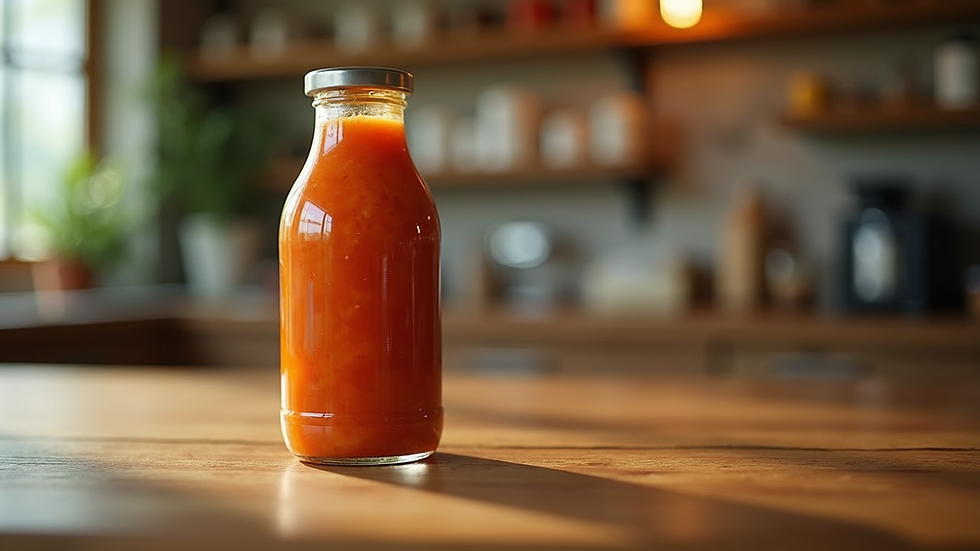How to Make Your Sauce Retail-Ready
- dupuispackage
- Aug 14
- 4 min read
Creating a sauce that stands out on retail shelves is no small feat. Whether you are a home cook looking to share your culinary creations or a small business aiming to expand your product line, making your sauce retail-ready involves several key steps. This guide will walk you through the essential elements to consider, from perfecting your recipe to designing eye-catching packaging.
Perfecting Your Recipe
The first step in making your sauce retail-ready is to ensure that your recipe is perfect. This means not only achieving the right flavor but also considering consistency and shelf stability.
Flavor Profile: Start by refining your sauce's flavor. Conduct taste tests with friends, family, or potential customers. Gather feedback and be open to making adjustments.
Consistency: The texture of your sauce is just as important as its flavor. A sauce that is too thick or too runny can deter customers. Aim for a consistency that complements the intended use of the sauce, whether it is for dipping, marinating, or cooking.
Shelf Stability: Consider how long your sauce can last without refrigeration. This is crucial for retail products. Research methods to enhance shelf life, such as using preservatives or adjusting pH levels.
Understanding Your Target Market
Knowing your audience is vital. Who will buy your sauce? Understanding your target market will help you tailor your product to meet their needs.
Demographics: Identify the age, gender, and lifestyle of your potential customers. Are they health-conscious individuals, busy parents, or gourmet food lovers?
Trends: Stay updated on food trends. For example, plant-based sauces are gaining popularity. If your sauce aligns with current trends, it may attract more customers.
Feedback: Engage with your audience through social media or local events. Ask for their opinions on flavors, packaging, and pricing. This feedback can guide your product development.
Packaging Design
Once your sauce is perfected, it’s time to think about packaging. Good packaging can make a significant difference in attracting customers.
Visual Appeal: Your packaging should be eye-catching. Use colors and designs that reflect the essence of your sauce. For example, a spicy sauce might use bold reds and oranges, while a fresh herb sauce could use greens.
Labeling: Ensure your label includes essential information such as ingredients, nutritional facts, and any certifications (like organic or gluten-free). Make sure the text is easy to read.
Sustainability: Consider using eco-friendly packaging. Many consumers today prefer products that are environmentally friendly. This can also be a selling point for your sauce.

Pricing Strategy
Setting the right price for your sauce is crucial. You want to cover your costs while remaining competitive.
Cost Analysis: Calculate the cost of ingredients, packaging, and labor. This will give you a baseline for pricing.
Market Research: Look at similar products in the market. What are they charging? This can help you position your sauce appropriately.
Value Proposition: Consider what makes your sauce unique. If it has special ingredients or a unique flavor, you may be able to charge a premium price.
Distribution Channels
Deciding how to get your sauce into the hands of consumers is another important step.
Local Stores: Start by approaching local grocery stores or specialty shops. Many are open to carrying products from local producers.
Farmers Markets: Selling at farmers markets can help you build a customer base and get direct feedback.
Online Sales: Consider setting up an online store. This can expand your reach beyond local customers.
Marketing Your Sauce
Once your sauce is ready for retail, it’s time to market it effectively.
Social Media: Use platforms like Instagram and Facebook to showcase your sauce. Share recipes, cooking tips, and customer testimonials.
Sampling Events: Organize tasting events at local stores or food festivals. This allows potential customers to try your sauce before buying.
Collaborations: Partner with local chefs or food bloggers. They can help promote your sauce to their audience.
Legal Considerations
Before launching your sauce, ensure you comply with all legal requirements.
Food Safety Regulations: Familiarize yourself with local food safety laws. This may include obtaining permits or licenses.
Labeling Laws: Ensure your labels meet all legal requirements, including ingredient lists and allergen warnings.
Insurance: Consider getting liability insurance to protect yourself in case of any issues with your product.
Continuous Improvement
Once your sauce is on the market, don’t stop there. Continuous improvement is key to long-term success.
Customer Feedback: Regularly seek feedback from customers. This can help you identify areas for improvement.
Product Variations: Consider developing new flavors or variations of your sauce. This can keep your product line fresh and exciting.
Stay Informed: Keep an eye on industry trends and adapt your product as needed. This will help you stay relevant in a competitive market.
Final Thoughts
Making your sauce retail-ready is a journey that requires careful planning and execution. From perfecting your recipe to designing attractive packaging, each step is crucial for success.
By understanding your target market, setting the right price, and effectively marketing your product, you can create a sauce that not only tastes great but also stands out on retail shelves.
Remember, the key to success is not just in creating a great product but also in continuously engaging with your customers and adapting to their needs. With dedication and creativity, your sauce can become a favorite among consumers.
So, roll up your sleeves, get cooking, and prepare to share your delicious sauce with the world!


Comments